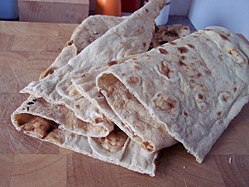 Kulcha with chole from India | |
| Type | Flatbread |
|---|---|
| Region or state | Punjab |
| Associated cuisine | Indian, Pakistani, Punjabi |
| Main ingredients | Maida |
Kulcha is a type of bread popular in Punjabi cuisine. It is made from refined wheat flour, and fermented in earthen pots and baked in a tandoor. [1] The term kultcha derives from a Persian term for a disc-shaped loaf of leavened bread. [2] Another variant of kulcha is khatai or sweet kulcha, which is prepared in a similar manner however sugar is added instead of salt. [3]
